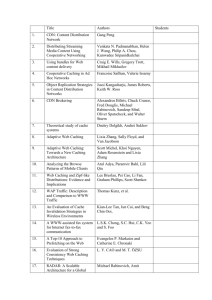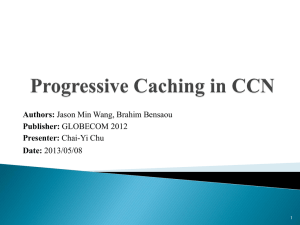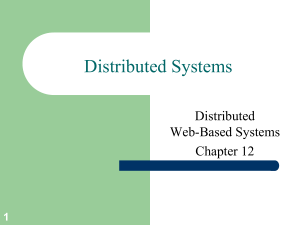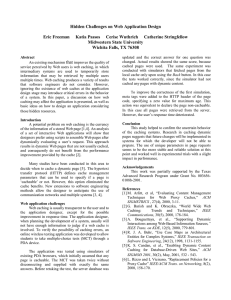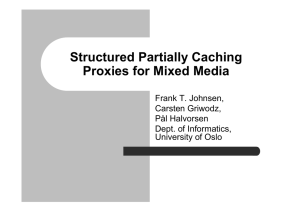Document 14210745
advertisement
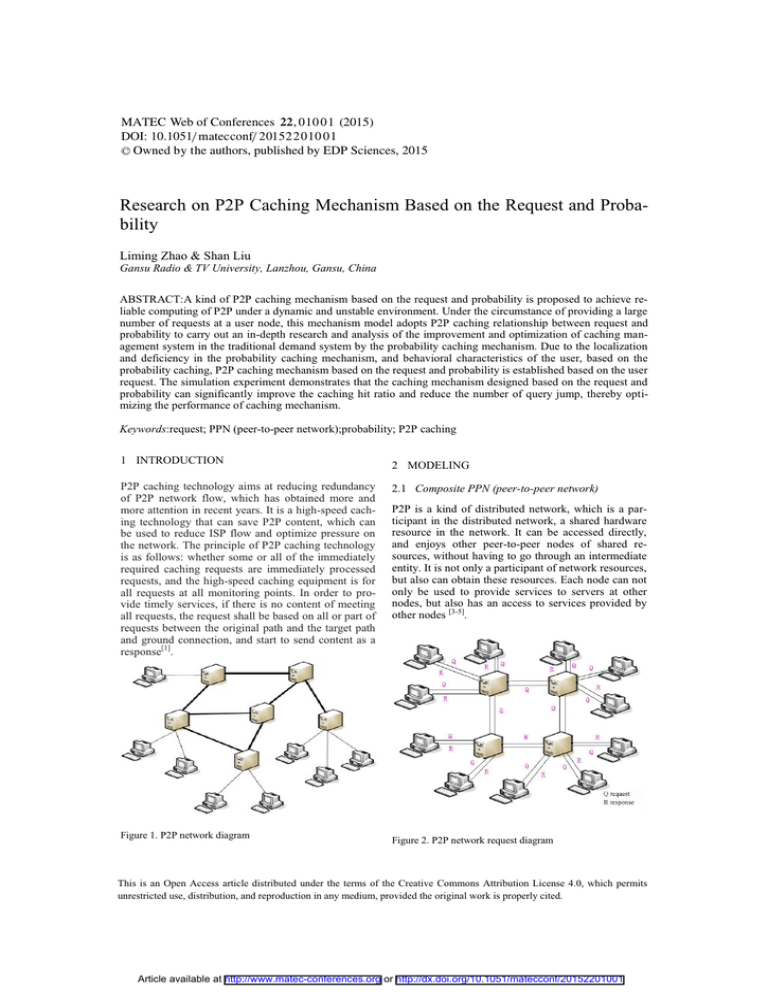
MATEC Web of Conferences 22 , 010 0 1 (2015) DOI: 10.1051/ m atec conf/ 201 5 2 2010 0 1 C Owned by the authors, published by EDP Sciences, 2015 Research on P2P Caching Mechanism Based on the Request and Probability Liming Zhao & Shan Liu Gansu Radio & TV University, Lanzhou, Gansu, China ABSTRACT:A kind of P2P caching mechanism based on the request and probability is proposed to achieve reliable computing of P2P under a dynamic and unstable environment. Under the circumstance of providing a large number of requests at a user node, this mechanism model adopts P2P caching relationship between request and probability to carry out an in-depth research and analysis of the improvement and optimization of caching management system in the traditional demand system by the probability caching mechanism. Due to the localization and deficiency in the probability caching mechanism, and behavioral characteristics of the user, based on the probability caching, P2P caching mechanism based on the request and probability is established based on the user request. The simulation experiment demonstrates that the caching mechanism designed based on the request and probability can significantly improve the caching hit ratio and reduce the number of query jump, thereby optimizing the performance of caching mechanism. Keywords:request; PPN (peer-to-peer network);probability; P2P caching 1 INTRODUCTION 2 MODELING P2P caching technology aims at reducing redundancy of P2P network flow, which has obtained more and more attention in recent years. It is a high-speed caching technology that can save P2P content, which can be used to reduce ISP flow and optimize pressure on the network. The principle of P2P caching technology is as follows: whether some or all of the immediately required caching requests are immediately processed requests, and the high-speed caching equipment is for all requests at all monitoring points. In order to provide timely services, if there is no content of meeting all requests, the request shall be based on all or part of requests between the original path and the target path and ground connection, and start to send content as a response[1]. 2.1 Composite PPN (peer-to-peer network) Figure 1. P2P network diagram Figure 2. P2P network request diagram P2P is a kind of distributed network, which is a participant in the distributed network, a shared hardware resource in the network. It can be accessed directly, and enjoys other peer-to-peer nodes of shared resources, without having to go through an intermediate entity. It is not only a participant of network resources, but also can obtain these resources. Each node can not only be used to provide services to servers at other nodes, but also has an access to services provided by other nodes [3-5]. This is an Open Access article distributed under the terms of the Creative Commons Attribution License 4.0, which permits unrestricted use, distribution, and reproduction in any medium, provided the original work is properly cited. Article available at http://www.matec-conferences.org or http://dx.doi.org/10.1051/matecconf/20152201001 MATEC Web of Conferences Figure 3. Composite overlay network Figure4.Block diagramof composite requests 2.2 Composite P2P networks The search of resources by nodes is generally first carried out in the local clusters. If the research is free of results, the research shall be based on super nodes. This method can effectively reduce network flow and improve search efficiency, and also improve load balancing of network to a certain extent. When the request sent by the user arrives at a node to search and query a search request, the value set by the user is stop [6]. If it fails to meet query results, there is a need to continue to send requests outward immediately, until the retrieval of all search nodes is over. In the case of an index node, assuming that the index node can simultaneously process n number of requests, when the strength of user request at an index node after reaching the system is , and the strength of index node is . Assuming that the maximum number of requests at the network searchnode is m, the maximum accommodate in the networkism number of userrequest, (m> n> 1). Ifthe requests havealready 01001-p.2 ICETA 2015 existedwithin the networksystem, the request in the network system is ( m n ). n 1 (np) k (np) n 1 p m n 1 1 n! 1 k 0 k! p0 1 n 1 k nn n ( m n 1 ) k! n! k 0 1k nk k p p0 k! 0 k ! pk k n k 1 p 0 n p 0 n! n!n k n 1 1 0k n nkm n 1 (np) k (np) n 1 p mn1 p 0 1 n! k 0 k! 1 nn m p0 n! Q 1 pm (3) Number of requests in search L pm e (1 pm ) Q (4) Average number of the indexnode e (5) When the search request is at an index node [7] m Lq (k n) p k k n Ls Lq L0 Lq WS LS e Wq e 3 PROBALITY CACHING MECHANISM Theemphasis of this paper is caching mechanism based on the user request, improvement and perfection of the performance of P2Pcaching mechanism [8]. Maincontent ofcachingmanagement of P2Pstreamingmedia is respectively as follows: a. cachingpre-fetch; b. caching replacement algorithm; c. management of cache region. For the probabilitycaching of the entireinstitutional mechanism based on the caching capacity of P2Pnetwork node, its main steps are as follows: pre-fetch and expand nodes and sufficient databreakpointsto increase theperformance of the system, andcorresponding nodes randomly request to divide data bufferto expandthe scope of caching block of the target data [9]. Themodel is shown in Figure6. 3.2 Caching strategy (2) Relative ability of thesearchnode Lk Lq 3.1 Probability caching management (1) Loss probability of requests at the search node pm Wq 1 e (1)Caching space There is a need to process unforeseennetwork jitter, and adopt the advantages ofnetwork bandwidth toimprove the chances ofsharingdata block. Its node not only needs to cache the data block with higher timeliness, but also improves relatively advanced download by the caching data block as far as possible under the conditions of bandwidth allowable [10]. The caching space can be divided into three buffers: main buffer, forward bufferand backwardbuffer. (2)Caching strategy From theglobalperspective,datasharing and dataexchangeoccur in the local part of themedia stream. Within the scope of the length of data block, the local part of media stream for the node caching is shown in Figure 8. The nature of caching is that, in the entire region, the need of data block is reduced due to limited caching objects, thus ensuring the caching redundancy in the data block at the node required. As shown in the figure for trichotomy, ifP2Pstreamingmedia demandsystemisa completely continuous high-speed caching mode, and the node at the segment of caching sharing and data exchange is a comprehensivestreaming media file, in order to ensure betterdataredundancy, the size of total caching shall be greater thanthat of the scope of caching required. (3)Method of probabilitycaching The caching mechanism based on the request and probability is to correspond with small node caching space theoretically and large node caching space 01001-p.3 MATEC Web of Conferences logically, so as toachieve a magnifiedeffect. The mechanism to achieve effect is: to select from all request data by the use of probability, and save a part in the caching, and the selected probability is varied. The playback caching probability closer to the node is larger than the playback caching probability farther than the node. Assuming that caching unit is Bi 1 , k islarger than j , k is not necessarilyequal to j 1 [11]. 01001-p.4 ICETA 2015 Figure5. Overall architecturediagram of demandsimulationsystem of P2Pstreaming media Figure 6.Diagram ofnode caching mechanism 01001-p.5 MATEC Web of Conferences Figure7. Way to divide buffers in the probabilitycaching Figure8.Comparison of the cachingtarget range Table1. Division table of probabilitybuffer Buffer space Actual caching size /size of caching target range Primary caching Forward / backward primary buffer 120/120 45/90 Forward / backward secondary buffer Forward / backward third buffer Forward / backward fourth buffer Forward / backward fifth buffer 20/90 Primary caching Forward / backward primary buffer 15/90 6/90 Forward / backward sixth buffer 1/90 01001-p.6 ICETA 2015 Figure9.Experimental environment Figure 10.Averagestart delay in node Figure 11.Averageloss rate of requests 01001-p.7 MATEC Web of Conferences Figure 12.Server load 4 SIMULATION EXPERIMENT AND PERFORMANCE ANALYSIS 4.1 Experimental environment To select 50 to 120 Stubnodes as peer-to-peer nodes, the outputbandwidth of the user node is[100 to 500] kbps, the outputbandwidth of theserver is 100Mbps, and theinput bandwidth is [400to1000] Kbps. The playback time of selected streaming media file is30 minutes, and the user node is added into the network by a way of Poissondistribution. Among them, the caching ratio is 0.5, the node caching is 300s, secondary caching is 180s, and primary caching is 120s, which are shown in Table 1. 4.2 Experimental procedure and results analysis quests at a user node. Due to the localization and deficiency in the probability caching mechanism, and behavioral characteristics of the user, based on the probability caching, P2P caching mechanism based on the request and probability is established based on the user request. A simulation experiment is carried out for the probability caching mechanism and the probability caching mechanism based on the behavioral characteristics of the user and popularity of the content. The simulation experiment demonstrates that the caching mechanism designed based on the request and probability can significantly improve the caching hit ratio and reduce the number of query jump, thereby optimizing the performance of caching mechanism. REFERENCES (1) Start delay in playback (2) Consecutive degree of playback (3) Serverload A simulationexperiment is carried out for the caching mechanismbased on the request and probability, and a simulationexperiment is also carried out for the traditional probability caching mechanism, and the caching mechanismbased on the request and probability. The experiment results show that, in the limitedcapacity of the server, the request andprobability ofP2Pcaching mechanismcan adjustone node tothe quality of media, and can also effectively improve thestability of the networkenvironment under a highlosssituation. The performance of the system has a small mitigation. Therefore, it has verified the enforceability of anew mechanism. 5 CONCLUSION This paper mainly carries out an in-depth research and analysis of the improvement and optimization of caching management system in the traditional demand system by the probability caching mechanism under the circumstance of providing a large number of re- [1] Yang Chuandong, Yu Zhenwe. &Wang Xinggang. 2005. Research on the composite streaming media system based on CDN and P2P technology. Computer Applications, (9): 2204-2207. [2] Wang Wenbo. 2009. Caching and scheduling strategy of P2P streaming media. Master’s Thesis of Northwest University. [3] Feng Jian, Fang Dingyi. & Pan Yafeng. 2008. Node selection algorithm in a kind of composite P2P streaming media demand system. Journal of Northwest University: Natural Science Edition, 38 (2): 199-202. [4] Xiao Mingzhong, Li Xiaoming. & Liu Hanyu. 2004. Caching replacement strategy of the proxy server based on the byte usefulness in a streaming media file.Journal of Computers, 27 (12): 1633-1641. [5] Zhang Weifeng. & Zhang Daiyuan. 2006. Improvement in P2P network based on search method of file route model. Computer Technology and Development.12, 16(12):111-113. [6] Lu Hao. 2005. P2P network modeling and simulation based on file sharing. Master’s thesis of Lanzhou University. [7] ChuanshaoZeyun.2006. Network working environment based on P2P technology. Gansu Scientific & Technology. 35 (6): 14-15. 01001-p.8 ICETA 2015 [8] Chen Xiaoming. & Li Zhoujun. 2006. PZP system performance optimization: Research summary. Computer Science. 11, 33 (11): 21-24. [9] Zhang Guolong. & Shan Zhiping. 2006. Research and implementation of access control model based on JXTAP2P. Microcomputer Information. 22 (2-3). [10] Ma Yuntao. 2004. Research and implementation of resource search research in the network file storage and sharing system. Master’s thesis of Southeast University. [11] Shi Ping, Chen Zhenxiang. &Jingshan.2007. P2P traffic identification method based on peer-to-peer characteristics. Network measurement and planning. 2. 01001-p.9
